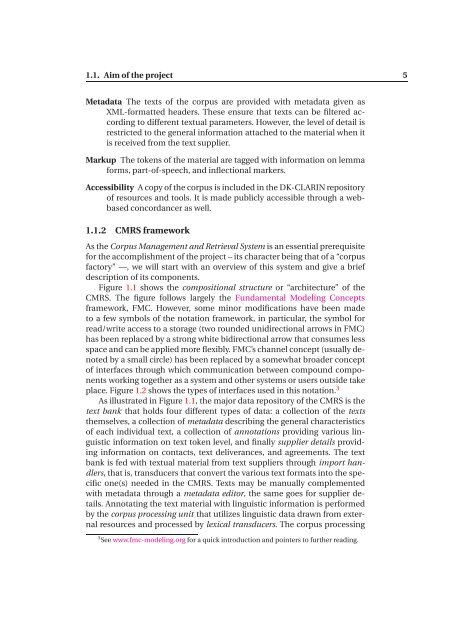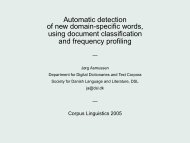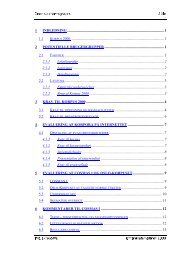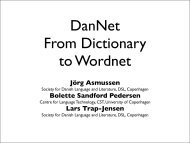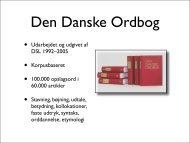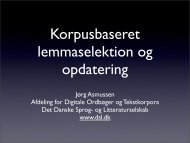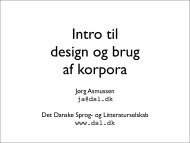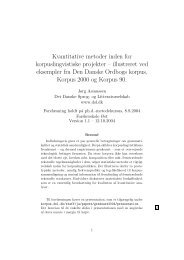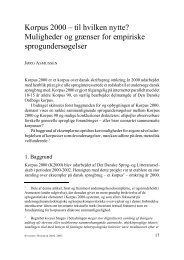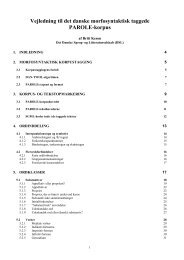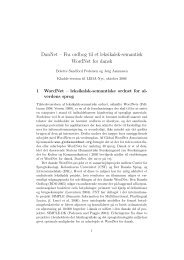The Corpus Thread - Det Danske Sprog- og Litteraturselskab
The Corpus Thread - Det Danske Sprog- og Litteraturselskab
The Corpus Thread - Det Danske Sprog- og Litteraturselskab
Create successful ePaper yourself
Turn your PDF publications into a flip-book with our unique Google optimized e-Paper software.
1.1. Aim of the project 5<br />
Metadata <strong>The</strong> texts of the corpus are provided with metadata given as<br />
XML-formatted headers. <strong>The</strong>se ensure that texts can be filtered according<br />
to different textual parameters. However, the level of detail is<br />
restricted to the general information attached to the material when it<br />
is received from the text supplier.<br />
Markup <strong>The</strong> tokens of the material are tagged with information on lemma<br />
forms, part-of-speech, and inflectional markers.<br />
Accessibility A copy of the corpus is included in the DK-CLARIN repository<br />
of resources and tools. It is made publicly accessible through a webbased<br />
concordancer as well.<br />
1.1.2 CMRS framework<br />
As the <strong>Corpus</strong> Management and Retrieval System is an essential prerequisite<br />
for the accomplishment of the project – its character being that of a “corpus<br />
factory” ––, we will start with an overview of this system and give a brief<br />
description of its components.<br />
Figure 1.1 shows the compositional structure or “architecture” of the<br />
CMRS. <strong>The</strong> figure follows largely the Fundamental Modeling Concepts<br />
framework, FMC. However, some minor modifications have been made<br />
to a few symbols of the notation framework, in particular, the symbol for<br />
read/write access to a storage (two rounded unidirectional arrows in FMC)<br />
has been replaced by a strong white bidirectional arrow that consumes less<br />
space and can be applied more flexibly. FMC’s channel concept (usually denoted<br />
by a small circle) has been replaced by a somewhat broader concept<br />
of interfaces through which communication between compound components<br />
working t<strong>og</strong>ether as a system and other systems or users outside take<br />
place. Figure 1.2 shows the types of interfaces used in this notation. 3<br />
As illustrated in Figure 1.1, the major data repository of the CMRS is the<br />
text bank that holds four different types of data: a collection of the texts<br />
themselves, a collection of metadata describing the general characteristics<br />
of each individual text, a collection of annotations providing various linguistic<br />
information on text token level, and finally supplier details providing<br />
information on contacts, text deliverances, and agreements. <strong>The</strong> text<br />
bank is fed with textual material from text suppliers through import handlers,<br />
that is, transducers that convert the various text formats into the specific<br />
one(s) needed in the CMRS. Texts may be manually complemented<br />
with metadata through a metadata editor, the same goes for supplier details.<br />
Annotating the text material with linguistic information is performed<br />
by the corpus processing unit that utilizes linguistic data drawn from external<br />
resources and processed by lexical transducers. <strong>The</strong> corpus processing<br />
3 See www.fmc-modeling.org for a quick introduction and pointers to further reading.


